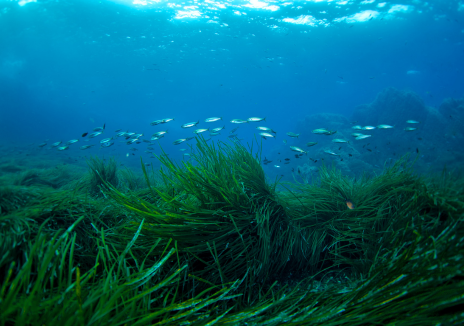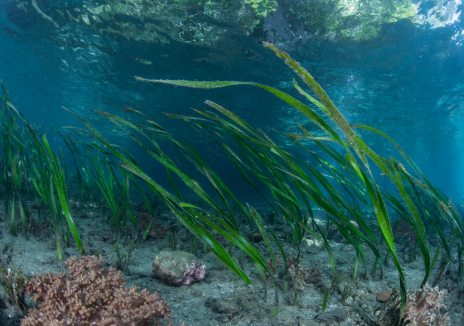Beneath the ocean’s surface lies an unsung hero of the marine world: seagrass. With around 60 species carpeting shallow waters across the globe, these vibrant underwater meadows are more than just plants, they're powerhouses of biodiversity, coastal protection, and climate regulation. Seagrass not only shelters marine life and stabilizes shorelines, but it also captures carbon up to 35 times faster than tropical rainforests.
Yet despite their vital role, these ecosystems are disappearing at an alarming rate, threatened by pollution, reckless anchoring, dredging, and the intensifying impacts of climate change. So what exactly makes seagrass so essential and what can we do to save it before it’s too late?
The Benefits of Seagrass: Nature’s Unsung Champion
What if one of the most powerful tools in the fight against climate change was swaying gently beneath the ocean’s surface? Seagrass is a vital form of blue carbon, which refers to carbon stored in coastal and marine ecosystems. Some seagrass species are especially efficient, capable of storing two to five times more carbon than equivalent areas of forest, and they do so at a much faster rate.
But seagrass isn’t just a carbon sink: it’s a lifeline. Seagrass meadows are highly effective and productive ecosystems. Considered a foundation species, seagrass modifies the environment to provide a valuable habitat that enables a variety of species to thrive. Their long, grass-like leaves provide spawning surfaces for many fish species, such as Pacific herring, along with foraging and sheltering areas for young fish, crabs, and other invertebrates. Seagrasses are also the primary food source for vulnerable grazers, such as sea turtles and dugongs.
One estimate indicates that seagrass meadows support the production of one-fifth of the world's largest fisheries, as they provide essential nursery grounds for many commercially important species. Seagrass meadows are therefore highly valuable to both human and marine life, supporting economies and providing food security for millions of people while sustaining critical species in the food web. In the United States, seagrass meadows are designated as “Essential Fish Habitats” under the 1996 Magnuson-Stevens Fishery Conservation and Management Act, highlighting their importance for the breeding, feeding, and growth to maturity of managed fish species. Some seagrass meadows have been further designated as “Habitat Areas of Particular Concern” due to their rarity, sensitivity to degradation, or ecological significance. These regions are prioritized for conservation.
The ecosystem benefits provided by seagrass go beyond the food web. Seagrass improves ocean water quality by trapping fine particles that harm marine life, such as excess nutrients, bacterial pathogens, pollutants, and suspended sediment. Through photosynthesis, seagrass produces oxygen and absorbs carbon dioxide from the water, enabling aerobic species to survive while reducing ocean acidity. Their extensive root systems stabilize the ocean floor, slow water flow, and mitigate the effects of erosion caused by waves and storms, safeguarding both the local marine environment and populated coastal areas.
Nature’s Champion at Risk: The Growing Threats to Seagrass
A 2021 study by the United Nations found that seagrass meadows and other coastal ecosystems are among the most threatened habitats in the world, as a result of dredging, pollution, and disease. In the UK alone, 44% of seagrass has been lost since 1936. These historical levels could have stored 11.5 metric tonnes of carbon and supported approximately 400 million fish. Similarly, in the western Mediterranean, research suggests that seagrass beds have declined by 34% over the last 40 years.
Warming waters have also indirectly impacted seagrass survival. Where solar irradiance and nutrient levels are high, warmer waters can cause algae to grow faster, leading to the formation of harmful algal blooms (HABs). These blooms block sunlight from reaching the seafloor, limiting the amount available for seagrass photosynthesis. Higher temperatures have also increased the spread of invasive species, such as the European green crab, which eats seedlings and uproots mature plants, affecting the seagrass’s ability to thrive.
Saving Seagrass: What You Can Do to Make a Difference
Seagrass is incredibly beneficial to both humans and marine life, but global threats highlight the urgent need for conservation and restoration. Fortunately, many organizations are stepping up. Research shows that once harmful impacts are removed, seagrass can regrow successfully. For example, seeds planted in Virginia bays in 1999 have now expanded into 4,700 acres of healthy meadows.
A critical part of restoration is mapping. Knowing where seagrass meadows remain helps determine how best to protect them. In boating-heavy regions like Spain, apps like Projecte Posidonia alert users when they’re near seagrass and prevent illegal anchoring. In Florida, boaters face fines for propeller scarring, which damages seagrass roots and leaves. Enforcement, signage, and education help reduce these impacts.
Restoration efforts are growing. In the UK, Project Seagrass has successfully planted several hectares across the Solent, north Wales, and Plymouth Sound, with more projects underway in Scotland and the Greater Thames Estuary.
Seagrass projects exist worldwide, and anyone can help. Whether by recording sightings at seagrassspotter.org or planting seedlings as a volunteer or citizen scientist, there are countless ways to get involved in protecting this vital ecosystem.
Protecting seagrass means protecting the future of our oceans and our planet. The International SeaKeepers Society believes that with collective action, innovation, and community support, we can ensure these underwater meadows continue to thrive for generations to come.
Sources
- https://noc.ac.uk/under-the-surface/seagrass?gad_source=1&gclid=CjwKCAjwktO_BhBrEiwAV70jXlNLQsxLB-6hMypWCR6uLTKZfG6GImgvOstXKIlTcyikdavFyCcEBxoCd2QQAvD_BwE
- https://www.seacology.org/key-habitats-we-protect/why-seagrass/?gad_source=1&gclid=CjwKCAjwktO_BhBrEiwAV70jXtZDLKjX-8wJjvNIPEylNLGWUUn2ZGqtBtqFPGTT9yN9xaq4V6WxexoCcpQQAvD_BwE
- https://www.frontiersin.org/journals/plant-science/articles/10.3389/fpls.2021.629962/full
- https://floridadep.gov/rcp/rcp/content/seagrass-restoration-efforts#:~:text=RCP%20has%20employed%20a%20variety,Andrews%20Bay%20and%20Pensacola%20Bay.
- https://www.nature.scot/scotlands-most-ambitious-seagrass-planting-scheme-starts-today
- https://www.projectseagrass.org/




